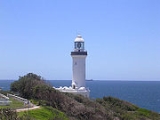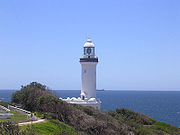
Norah Head, New South Wales
Encyclopedia
- Not to be confused with NowraNowra, New South WalesNowra is a city in the South Coast region of New South Wales, Australia. Located SSW and approximately by road south of the state capital of Sydney, it has an estimated population together with its twin-town of Bomaderry of 34,479. It is also the seat and commercial centre of the City of Shoalhaven...

Headlands and bays
Headlands and bays are two related features of the coastal environment.- Geology and geography :Headlands and bays are often found on the same coastline. A bay is surrounded by land on three sides, whereas a headland is surrounded by water on three sides. Headlands are characterized by high,...
on the Central Coast, New South Wales
Central Coast, New South Wales
The Central Coast is an urban region in the Australian state of New South Wales, located on the coast north of Sydney and south of Lake Macquarie....
, Australia
Australia
Australia , officially the Commonwealth of Australia, is a country in the Southern Hemisphere comprising the mainland of the Australian continent, the island of Tasmania, and numerous smaller islands in the Indian and Pacific Oceans. It is the world's sixth-largest country by total area...
, south of Newcastle
Newcastle, New South Wales
The Newcastle metropolitan area is the second most populated area in the Australian state of New South Wales and includes most of the Newcastle and Lake Macquarie Local Government Areas...
and north of Sydney. The nearest town is Toukley. The place is home to a lighthouse with scenic views, which is also considered a venue for weddings. The Norah Head tidal rock pool next to the Cabbage Tree harbour is a popular destination for families with young children due to its sheltered location.
Lighthouse
The Norah Head Lighthouse was the last significant lighthouseLighthouse
A lighthouse is a tower, building, or other type of structure designed to emit light from a system of lamps and lenses or, in older times, from a fire, and used as an aid to navigation for maritime pilots at sea or on inland waterways....
built in New South Wales, a 27 m tower, completed in 1903 with monetary assistance /Hargraves of Noraville after considerable numbers of ships foundered on the coast near the headland
Headland
A headland is a point of land, usually high and often with a sheer drop, that extends out into a body of water.Headland can also refer to:*Headlands and bays*headLand, an Australian television series...
. Originally it was powered by a kerosene
Kerosene
Kerosene, sometimes spelled kerosine in scientific and industrial usage, also known as paraffin or paraffin oil in the United Kingdom, Hong Kong, Ireland and South Africa, is a combustible hydrocarbon liquid. The name is derived from Greek keros...
concentric wick lamp and still today it features a 2nd order bivalve Fresnel lens
Fresnel lens
A Fresnel lens is a type of lens originally developed by French physicist Augustin-Jean Fresnel for lighthouses.The design allows the construction of lenses of large aperture and short focal length without the mass and volume of material that would be required by a lens of conventional design...
prism floating on a mercury
Mercury (element)
Mercury is a chemical element with the symbol Hg and atomic number 80. It is also known as quicksilver or hydrargyrum...
bath. At first, the prism
Prism (optics)
In optics, a prism is a transparent optical element with flat, polished surfaces that refract light. The exact angles between the surfaces depend on the application. The traditional geometrical shape is that of a triangular prism with a triangular base and rectangular sides, and in colloquial use...
was rotated by descending weights, but the light was electrified in 1961 and fully automated in 1995. The light flashes once in 15 seconds, and is visible to 27 nautical miles (50 km), the focal plane is located at 46 m above sea level. For coastal shipping, two additional light signals are shown: a red light in the northeast sector, emitted from 39 m above the sea and a green one towards southwest, emitted from 44 m; both are continuous.
The former lighthouse keepers cottage (Head Keeper's separate cottage and two assistants semi-detached quarters) are maintained, and two of these are available for rent.
World War II
Near the head, sea battles between the Japanese NavyImperial Japanese Navy
The Imperial Japanese Navy was the navy of the Empire of Japan from 1869 until 1947, when it was dissolved following Japan's constitutional renunciation of the use of force as a means of settling international disputes...
and Merchant navy
Merchant Navy
The Merchant Navy is the maritime register of the United Kingdom, and describes the seagoing commercial interests of UK-registered ships and their crews. Merchant Navy vessels fly the Red Ensign and are regulated by the Maritime and Coastguard Agency...
ships took place in World War II
World War II
World War II, or the Second World War , was a global conflict lasting from 1939 to 1945, involving most of the world's nations—including all of the great powers—eventually forming two opposing military alliances: the Allies and the Axis...
: Two ships were sunk, Nimbin (1067 tonnes) by a mine on 5 December 1940 and BHP
BHP Billiton
BHP Billiton is a global mining, oil and gas company headquartered in Melbourne, Australia and with a major management office in London, United Kingdom...
's Iron Chieftain (4877 tonnes) by a submarine
Submarine
A submarine is a watercraft capable of independent operation below the surface of the water. It differs from a submersible, which has more limited underwater capability...
on 3 June 1942. The Age (4775 tonnes) was also attacked on 3 June 1942.
Landforms
There are several unique landforms around the head. Immediately in front of the head there is a rock platform which was formed in the PermianPermian
The PermianThe term "Permian" was introduced into geology in 1841 by Sir Sir R. I. Murchison, president of the Geological Society of London, who identified typical strata in extensive Russian explorations undertaken with Edouard de Verneuil; Murchison asserted in 1841 that he named his "Permian...
to Triassic
Triassic
The Triassic is a geologic period and system that extends from about 250 to 200 Mya . As the first period of the Mesozoic Era, the Triassic follows the Permian and is followed by the Jurassic. Both the start and end of the Triassic are marked by major extinction events...
periods around 180 - 280 million years ago. In the platform there is a volcanic intrusion, a channel of darker rock running from one side of the platform to the other. The intrusion was created by waves quarrying a softer basalt lava flow out of the surrounding granite. The lava came from an ancient volcano, probably Mount Warrawolong to the west.

